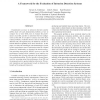129
click to vote
SP
2006
IEEE
15 years 6 months ago
2006
IEEE
The number and the importance of Web applications have increased rapidly over the last years. At the same time, the quantity and impact of security vulnerabilities in such applica...
98
Voted
SP
2006
IEEE
15 years 6 months ago
2006
IEEE
Simulatable security is a security notion for multi-party protocols that implies strong composability features. The main definitional flavours of simulatable security are standa...
65
Voted
SP
2006
IEEE
15 years 6 months ago
2006
IEEE
104
click to vote
SP
2006
IEEE
15 years 6 months ago
2006
IEEE
Linux is the most popular open source project. The Linux random number generator is part of the kernel of all Linux distributions and is based on generating randomness from entrop...
75
Voted
SP
2006
IEEE
15 years 6 months ago
2006
IEEE
An all too real threat to the privacy offered by a mix network is that individual mix administrators may volunteer partial tracing information to a coercer. While this threat can ...
104
Voted
SP
2006
IEEE
15 years 6 months ago
2006
IEEE
Classification accuracy in intrusion detection systems (IDSs) deals with such fundamental problems as how to compare two or more IDSs, how to evaluate the performance of an IDS, ...
107
Voted
SP
2006
IEEE
15 years 6 months ago
2006
IEEE
Inspired by unidirectional error detecting codes that are used in situations where only one kind of bit errors are possible (e.g., it is possible to change a bit “0” into a bi...
105
Voted
SP
2006
IEEE
15 years 6 months ago
2006
IEEE
In this paper we explore the problem of creating vulnerability signatures. A vulnerability signature matches all exploits of a given vulnerability, even polymorphic or metamorphic...
SP
2006
IEEE
15 years 6 months ago
2006
IEEE
With the growing popularity of anomaly detection systems, which is due partly to the rise in zero-day attacks, a new class of threats have evolved where the attacker mimics legiti...
109
Voted
SP
2006
IEEE
15 years 6 months ago
2006
IEEE
We present a new mechanized prover for secrecy properties of security protocols. In contrast to most previous provers, our tool does not rely on the Dolev-Yao model, but on the co...







